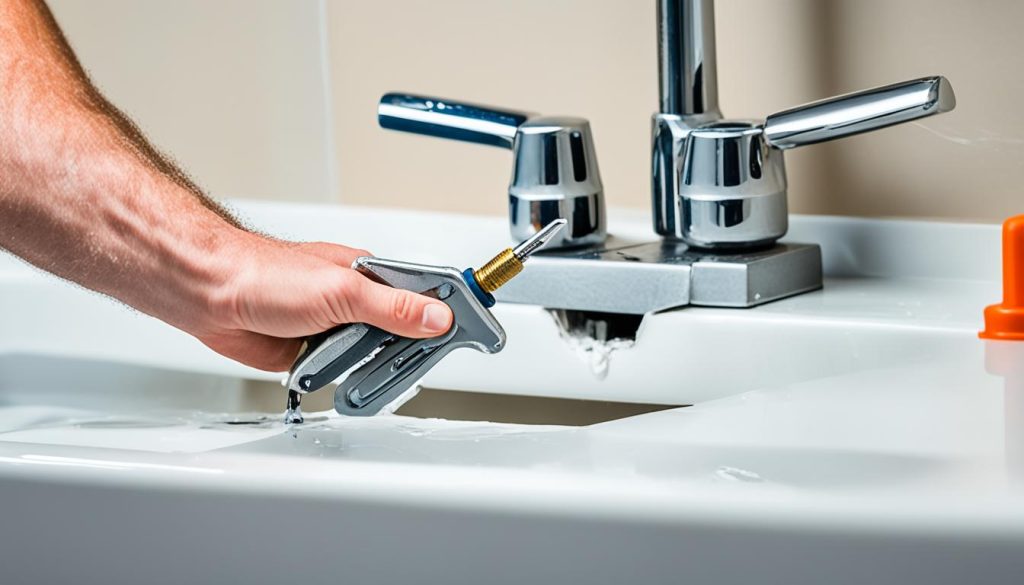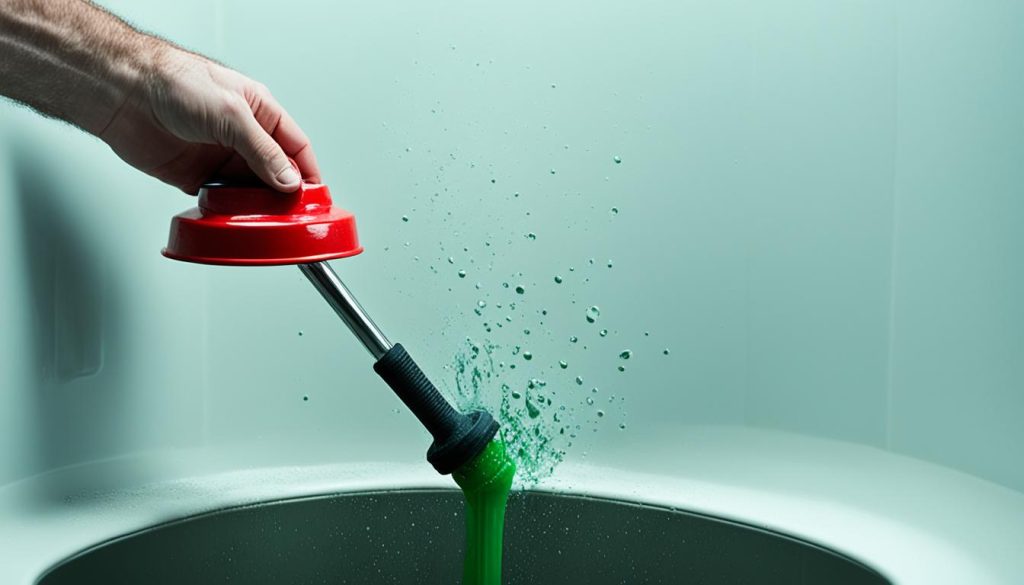Understanding a Lavatory in Plumbing – Quick Guide
Did you know that the average person will spend approximately 1.5 years of their life in the bathroom? That’s a significant amount of time dedicated to personal hygiene and relaxation. And at the heart of every bathroom is the lavatory, also known as the bathroom sink or washbasin.
A lavatory plays a crucial role in plumbing systems, providing a basin for washing hands, face, and other personal hygiene activities. But there’s more to it than meets the eye. In this quick guide, I’ll explain the definition of a lavatory, its installation process, repair tips, maintenance requirements, and the components that make up lavatory plumbing systems.
Key Takeaways:
- A lavatory, also known as a bathroom sink or washbasin, is an essential fixture in plumbing systems.
- Understanding the purpose and installation process of a lavatory is crucial for a functional and efficient plumbing system in your home.
- Hiring professional lavatory plumbing services ensures a seamless and successful installation.
- Regular maintenance and following manufacturer guidelines are key to optimal lavatory functionality.
- Lavatory plumbing systems consist of various components, including supply lines and drain lines.
Lavatory Installation Process
When it comes to installing a lavatory, there are several important steps to follow. The process begins with the rough-in stage, where accurate measurements are taken to ensure that the plumbing meets the manufacturer’s specifications. This includes determining the dimensions for the supply lines, discharge or drain holes, and positioning the fixture in relation to other elements in the bathroom.
To ensure a seamless and successful installation, it is recommended to hire professional lavatory plumbing services. Their expertise and experience will ensure that the installation is done correctly, preventing potential issues down the line.
Here is a step-by-step breakdown of the lavatory installation process:
- Measure and mark the placement of the lavatory on the wall.
- Shut off the water supply to the bathroom.
- Disconnect the existing plumbing connections, if applicable.
- Install the faucet onto the lavatory, following the manufacturer’s instructions.
- Attach the supply lines to the faucet and connect them to the water supply.
- Secure the lavatory to the wall with the appropriate mounting brackets.
- Connect the drain pipe to the lavatory’s drain hole.
- Apply plumbers’ putty or silicone sealant around the edges of the lavatory to create a watertight seal.
- Turn on the water supply and check for any leaks.
By following these steps and enlisting the help of professionals, you can ensure a smooth and successful lavatory installation.
Image related to Lavatory Installation Process:
https://www.youtube.com/watch?v=o98yEP9l7XM
Lavatory Repair Tips
Over time, lavatories may experience common issues such as leaks, clogs, or damaged components. While consulting a lavatory plumbing specialist is recommended for professional repairs, there are some basic repair tips that homeowners can follow to address minor problems and ensure the optimal functionality of their lavatory plumbing systems.
Fixing Minor Leaks
If you notice a minor leak in your lavatory, you can attempt to fix it yourself before seeking professional assistance. Start by turning off the water supply using the shut-off valve located underneath the sink. Next, inspect the source of the leak, which could be a loose connection, a worn-out washer, or a damaged seal. Tighten any loose connections, replace worn-out washers, and apply plumber’s tape or sealant to repair damaged seals.
Unclogging Drains
A clogged drain can cause inconvenience and potential water damage if left unattended. In many cases, you can unclog a lavatory drain using a plunger or a drain snake. To use a plunger, place it over the drain opening and create a strong seal. Then, push and pull the plunger vigorously to dislodge the clog. If the plunger doesn’t work, you can try using a drain snake to break up the blockage and remove it from the drain pipe.
Replacing Faulty Parts
If you have a lavatory with a malfunctioning faucet or a cartridge that needs replacement, you can easily replace these faulty parts on your own. Start by turning off the water supply to the lavatory using the shut-off valve. Then, follow the manufacturer’s instructions to uninstall the old faucet or cartridge and install the new one. Be sure to use the appropriate tools and take note of the correct installation and alignment of the new parts.
Remember, these lavatory repair tips are intended for minor issues that homeowners can handle themselves. For more complex repairs or if you’re unsure about the cause of the problem, it’s always best to consult a lavatory plumbing specialist. Regular maintenance of your lavatory plumbing system is crucial to prevent major issues and ensure its optimal functionality.
Lavatory Maintenance for Optimal Functionality
Proper maintenance is key to ensuring the optimal functionality of a lavatory. By following these simple lavatory repair tips and regular upkeep, you can keep your lavatory plumbing systems in excellent condition. Let’s explore some essential maintenance practices:
1. Regular Cleaning
To prevent the buildup of dirt and grime, it’s important to clean your lavatory regularly. Use a mild cleanser and a soft cloth or sponge to wipe down the sink, faucets, and other components. Avoid using abrasive cleaners or harsh chemicals, as they can damage the finish or components of your lavatory.
2. Leak Detection
Periodically check for any leaks or drips in your lavatory plumbing systems. The presence of water pooling around the sink, under the cabinet, or in the drain area may indicate a leak. If you notice any leaks, it’s essential to address them promptly to prevent water damage and conserve water.
3. Drainage Inspection
Inspecting the drainage system is crucial for maintaining optimal lavatory functionality. Regularly check the drain area for any clogs or blockages. Use a plunger or a drain snake to remove minor clogs. If you encounter persistent or severe blockages, it’s recommended to seek professional assistance from a lavatory plumbing specialist.
4. Following Manufacturer Guidelines
Manufacturers provide specific guidelines for the maintenance of lavatory plumbing systems. These guidelines may include recommendations for cleaning products, frequency of maintenance, and tips for handling various issues. By following these guidelines, you can ensure that your lavatory remains in top-notch condition and functions efficiently for years to come.
Remember, proper lavatory maintenance not only prolongs the lifespan of your plumbing system but also helps you avoid costly repairs and inconveniences in the future.
Understanding Lavatory Plumbing Systems
Lavatory plumbing systems play a crucial role in providing both water supply and drainage for your bathroom sink. These systems consist of various components that work together to ensure a well-functioning lavatory.
The first key component of a lavatory plumbing system is the supply lines. These lines deliver fresh water to the lavatory, allowing you to wash your hands and perform other personal hygiene activities. It is essential to ensure that the supply lines are properly installed during the lavatory installation process to prevent any leaks or water pressure issues.
The second important component is the drain lines. These lines are responsible for removing wastewater from the lavatory and directing it towards the main drainage system. It is crucial to have well-designed and correctly installed drain lines to prevent clogs and ensure efficient waste removal.
To ensure the proper functioning of your lavatory plumbing system, it is recommended to consult plumbing professionals. They have the expertise to guide you through the installation process and provide valuable maintenance tips. Their knowledge and experience will help you avoid common pitfalls and ensure a long-lasting and efficient lavatory plumbing system.
Source Links
- https://www.warnerservice.com/a-quick-guide-to-your-bathroom-sink-plumbing
- https://www.thespruce.com/plumbing-rough-in-dimensions-guide-1822483
- https://www.linkedin.com/pulse/ultimate-guide-bathroom-plumbing-diagrams-layouts-benneth-obi
- Investing Wisely: How Windows & Doors in Boost Property Value and Financial Health - April 24, 2025
- The Financial Impact of Personal Injuries: Why Legal Help Matters for Business Owners - April 16, 2025
- The Hidden Financial Costs of Domestic Assault: What Business Owners Need to Know - April 16, 2025













